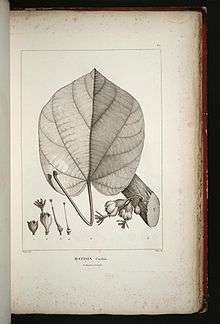Quararibea cordata
| Quararibea cordata | |
|---|---|
 | |
| Quararibea cordata, Illustration. | |
| Scientific classification | |
| Kingdom: | Plantae |
| (unranked): | Angiosperms |
| (unranked): | Eudicots |
| (unranked): | Rosids |
| Order: | Malvales |
| Family: | Malvaceae |
| Subfamily: | Bombacoideae |
| Genus: | Quararibea |
| Species: | Q. cordata |
| Binomial name | |
| Quararibea cordata Vischer | |
| Synonyms[1] | |
| |
.jpg)

Quararibea cordata (South American sapote, Chupa-chupa) is a large, semi-deciduous, fruit tree (up to 45m in height), native to Amazon Rainforest vegetation in Brazil, Colombia, Ecuador, and Peru. It bears orange-yellow fruit which are soft, juicy, sweet and contain 2-5 seeds. Fruit is usually eaten out of hand, though it may be juiced.[2]
Although generally popular, fruit quality is variable, with some trees producing insipid or fibrous fruits and little work has been done in establishing preferred cultivars. It grows best in wet, deep soils, but can be killed by floods.
Distribution
Quararibea cordata is native to the foothills of the Andes, and is common throughout parts of Brazil, Venezuela, and Colombia. However, it is not widely cultivated.[2]
Chupa-chupa has failed to gain much international recognition and has not been widely planted outside its native range. In 1964, US pomologist Bill Whitman obtained seeds from Peru and planted a tree in his garden at Bal Harbour, Florida, where it has successfully fruited.[3]
See also
References
| Wikimedia Commons has media related to Matisia cordata. |
- ↑ "The Plant List: A Working List of All Plant Species". Retrieved 19 August 2015.
- 1 2 Santos, Ronaldo Pereira (2006). "Quararibea cordata: South American sapote". In Jules Janick, Robert Paull. The Encyclopedia of Fruit and Nuts. Cambridge, MA: CABI. pp. 184–186. ISBN 9780851996387.
- ↑ Morton, J. 1987. Fruits of Warm Climates.
External links
- CIRAD-FLHOR/IPGRI: Matisia cordata
- Morton, Julia F., 1987. Chupa-chupa. p. 291–292. In: Fruits of warm climates. Julia F. Morton, Miami, FL.